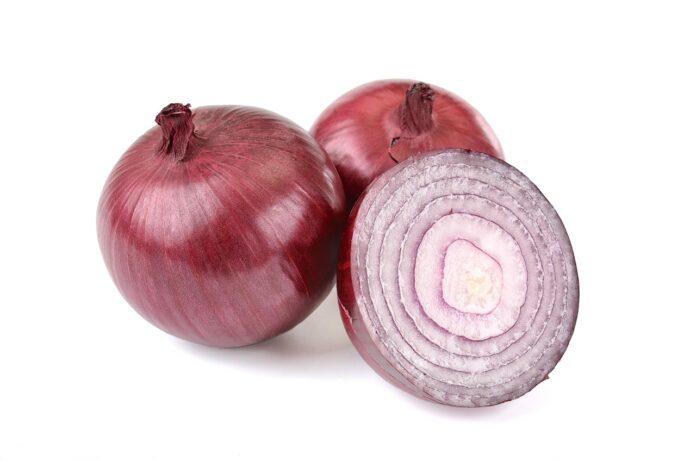Onions (Allium cepa) are one of the most widely cultivated and consumed vegetables worldwide, known for their distinctive flavor, versatility, and health benefits. They belong to the Allium genus, which also includes garlic, leeks, and shallots. Below is a detailed description of onions:
Varieties:
- Yellow Onions: The most common variety, known for their strong flavor and widely used in cooking. They are often used for caramelizing due to their sweetness when cooked.
- Red Onions: These onions have a milder flavor and a vibrant purple skin, commonly used in salads, sandwiches, or as garnish.
- White Onions: They have a sharper, more pungent taste compared to yellow onions and are often used in Mexican cuisine and raw applications.
- Shallots: A smaller, milder relative of the onion, often used in fine dining and sauces for their subtle flavor.
Interesting Facts About Onions:
- Tears from Onions: The tears you shed when chopping onions are caused by sulfur compounds released when the onion is cut. These compounds mix with enzymes in the onion and form a gas that irritates your eyes, causing them to produce tears
- Cultural Symbolism: In ancient Egypt, onions were highly valued, symbolizing eternity due to their layered structure. They were often placed in tombs, and their presence in burial sites suggested their spiritual importance
- Culinary versatility: Onions are used worldwide in a wide variety of dishes, such as soups, stews, sauces, and salads. They are integral to many foundational cooking techniques, like mirepoix (a mix of onions, carrots, and celery in French cuisine) and sofrito (a similar mix in Latin American dishes)
- Economic importance: Onions are one of the most widely grown vegetables globally. Countries like India, China, and the USA produce and export vast quantities, making onions a crucial part of the global agricultural economy
- Onion layers: The onion’s structure is unique, consisting of concentric layers called tunics, which protect the softer inner layers from environmental damage. These layers are the reason onions can survive in storage for long periods
- Sweet onions: Some onion varieties, like the Walla Walla and Vidalia onions, have a sweeter, milder flavor, making them ideal for raw consumption in salads and sandwiches. These varieties are particularly prized for their low sulfur content, which makes them less pungent
- Onion’s protective qualities: Historically, onions were used as a natural insect repellent. Their strong smell is known to repel pests like mosquitoes and flies, and they were even used in fields to keep bugs away from crops
- New York’s nickname: Before being known as the Big Apple, New York City was affectionately referred to as the Big Onion, a nickname reflecting the city’s layered history and bustling streets
- Onions and winter weather: An old English saying claims that the number of onion skins indicates how harsh the winter will be. Farmers would use this as a natural prediction tool for the weather, though it’s not scientifically proven
- Onions as currency: In ancient times, onions were so valuable that they were sometimes used as a form of currency. Workers in ancient Egypt and Greece were sometimes paid in onions instead of money
- Largest onion ever: The largest onion recorded by Guinness World Records weighed 10 pounds, 14 ounces (4.94 kg). It was grown in the UK, showcasing the enormous potential of this humble vegetable when grown under the right conditions
- Onions in art: Onions were often depicted in ancient Egyptian tomb art. They symbolized eternity, and their round shape was likened to the sun and moon, representing life and death cycles
- Onions and health: Historically, onions have been used in folk medicine for treating a variety of ailments, including coughs, colds, and respiratory infections. Their natural properties help clear mucus and promote better breathing
- Onions and pets: While onions are a staple in human diets, they are toxic to pets, especially dogs and cats. Consuming even small amounts of onions can cause serious health issues like anemia, leading to fatigue and other complications. See Why onions is dangerous for animals
- Onions in folklore: In some cultures, onions were believed to have magical properties. They were used as charms against evil spirits, and in some European traditions, onions were placed in the corners of homes to ward off witches
- Onion tears trick: To prevent crying when cutting onions, some suggest using a wooden spoon in your mouth. This old trick supposedly reduces the amount of sulfur compounds released into the air and may minimize tears
- Cold storage: When stored in a cool, dark place, onions can remain edible for months. This long shelf life makes them a valuable storage crop for many households
- Onions and vitamin C: In addition to antioxidants, onions are a good source of vitamin C, a critical nutrient for immune health and the production of collagen, which supports skin, bones, and tissues
- Onions in the Bible: Onions are mentioned several times in the Bible, where they were part of the Israelites’ diet during their exodus from Egypt. They were considered one of the staples of their sustenance
- Onion farming: In areas like Walla Walla, Washington, onions are grown specifically for their sweetness and mild flavor. These onions have become a point of pride for local agriculture, being a major part of the region’s economy
- Onion breath remedy: Eating parsley or drinking green tea can help neutralize the strong odor left by onions on your breath. These foods contain compounds that counteract the sulfur in onions
- Seasonal growth: Onions can be grown in different climates and seasons, which makes them an adaptable crop. In cooler regions, onions are typically planted in the spring and harvested in late summer, while in warmer climates, they can be grown year-round
